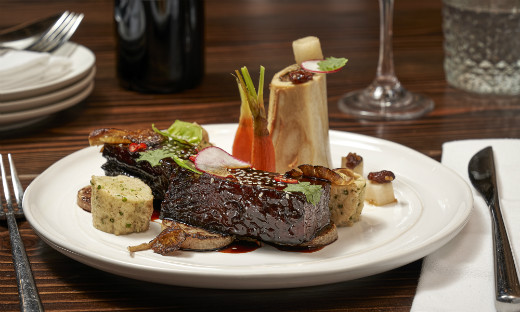For so long, kosher food meant food done the traditional way, making it just like Bubbie used to, especially in kosher restaurants. It was rare to find something truly innovative. But in recent years the kosher food world has exploded in depth and breadth, bringing an influx of expansive kosher ingredients that allow us to get far beyond brisket.
In recent years, I could tell that change was coming, but it seemed like every step was coming ever so gradually. The average home cook or diner-out seemed to be too intimidated to try some of these new flavors.
Sometimes it felt like only a few individuals were willing to really add new, unfamiliar ingredients and experiment, let alone in the kosher restaurant world where owners have to feel like there is a demand in the market for their product. Yes, we see ponzu marinated crudo on upscale kosher menus and Asian style fried wings- but all too often the changes have been tame, safe and close to home.
Then Boru Boru came along and flipped my expectations upside down. Boru Boru is a tiny little 30-seat restaurant with big goals, on Amsterdam and 98th, the Upper West Side of Manhattan. Boru Boru set out to prove that the kosher world is ready for a more brash and embracing approach to ethnic cuisine, in their homes, dining out and in the ingredients we look to certify.
I had the opportunity to dine at Boru Boru and speak with Chef Erick Vargas-Bromberg, and Dan Zelkowitz, the owner. They explained their inspiration behind opening up the shop and their mission as far as bringing ramen to the kosher world: “Surprise the kosher food world with something they have never tried before.”
Their food falls under the umbrella of Asian fusion with a sprinkling of traditional Jewish influences, but you won’t find sushi on the menu. Don’t go in asking for sesame chicken either. (Seriously guys, stop asking, they don’t sell it.)
Their menu features items like bao buns- pillowy soft folded bread with slices of smoked pastrami or marinated chicken and even mushroom topped with pickles, crunchy radish and a final note of bright nuance from the chives. The soft, crunchy, briny, sweet, a little spicy and salty flavor comes together for an incredible two bite adventure. Interestingly, as Dan points out, even though they look like bread, you don’t need to wash on bao buns, since they’re steamed, not baked.
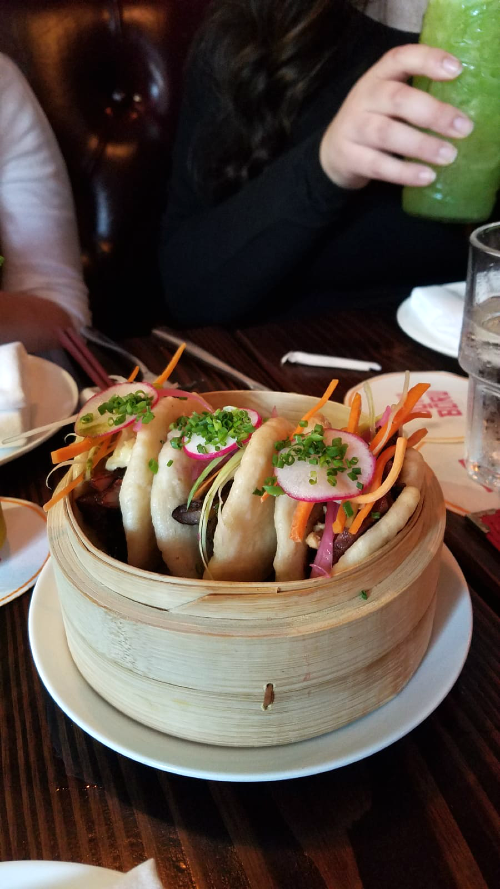
You can also find Tibetan style dumplings-the momo dumpling with its perfect folds pinched and glistening. They stand erect in a tiny steamer basket. Don’t expect an overly sweetened ginger heavy hard meatball in the center of these delicious dough pockets; expect a lightly nuanced flavor that is still strong and bold, reminiscent of French curry and tasting almost like pure zen.
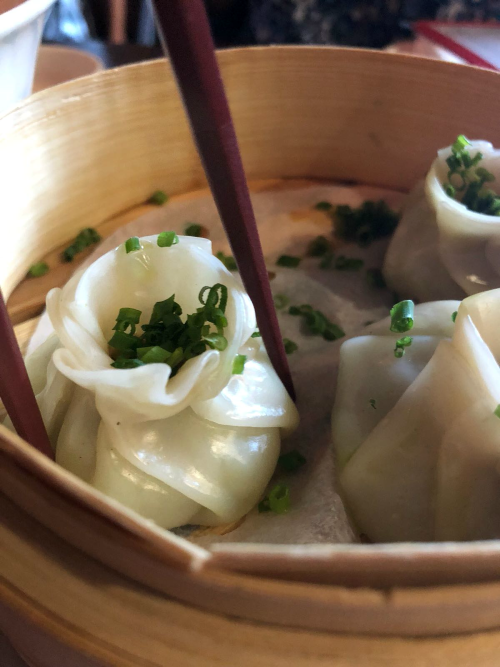
Even the fries are innovative. They are drizzled with an imitation kewpie mayonnaise (a thick, creamy mayonnaise that is less sweet and with more rice vinegar than your typical American mayonnaise) and sprinkled with togarashi, which is a Japanese spice with chili flakes and six other ingredients including nori, dried mandarin peel, and white poppy. The thin and crispy fries are served together with a charred eggplant dipping sauce which is full of umami and highly addictive.
Every dish on the menu has a story, an influence that helped it come to be. It’s evident when you taste it that serious care went into each component, that every mustard seed and peppercorn is used for a reason.
As with every one of the dishes we ordered, there is a fascinating story behind the pastrami ramen, one of the less-traditional ramen options.
Dan’s wife’s grandfather used to tell stories of his time in the restaurant supply business in Chinatown. He worked together with many Asian immigrants. Dan imagined what would it be like if they sat down to have lunch together, the grandfather’s traditional Jewish pastrami sandwich with mustard and the Japanese workers with their steaming bowls of ramen.
The idea for this dish became a bowl of exactly that fusion: house smoked pastrami with traditional coriander based rub with the added zing of Szechuan peppercorn topped with a sweet and pungent pickled mustard seed, and served in a traditional ramen broth with shredded Napa cabbage.
The experience of eating the dish takes you to that time, while the flavors meld together and become something completely new and different. The bowl is not for everyone, but for those who appreciate it, it is a masterpiece.
Find out the story behind Seoul-Style Braised Brisket with Farina Dumplings, Asian Pear, and Bone Marrow.
Their menu also features traditional Japanese, Chinese, and Korean dishes with readily available kosher-certified ingredients like miso, kombu, and sake; and some that they make on their own in-house, like koji, gochujang (a Korean fermented tangy chili paste), and bonito (dried and smoked fish that is shaved into basically concentrated umami). All of these are incredibly difficult and take real skill to make from scratch.
“My goal is to have people walk in here because it’s a ramen shop,” Dan says, “not necessarily because it’s a kosher place. We just happen to be kosher.”
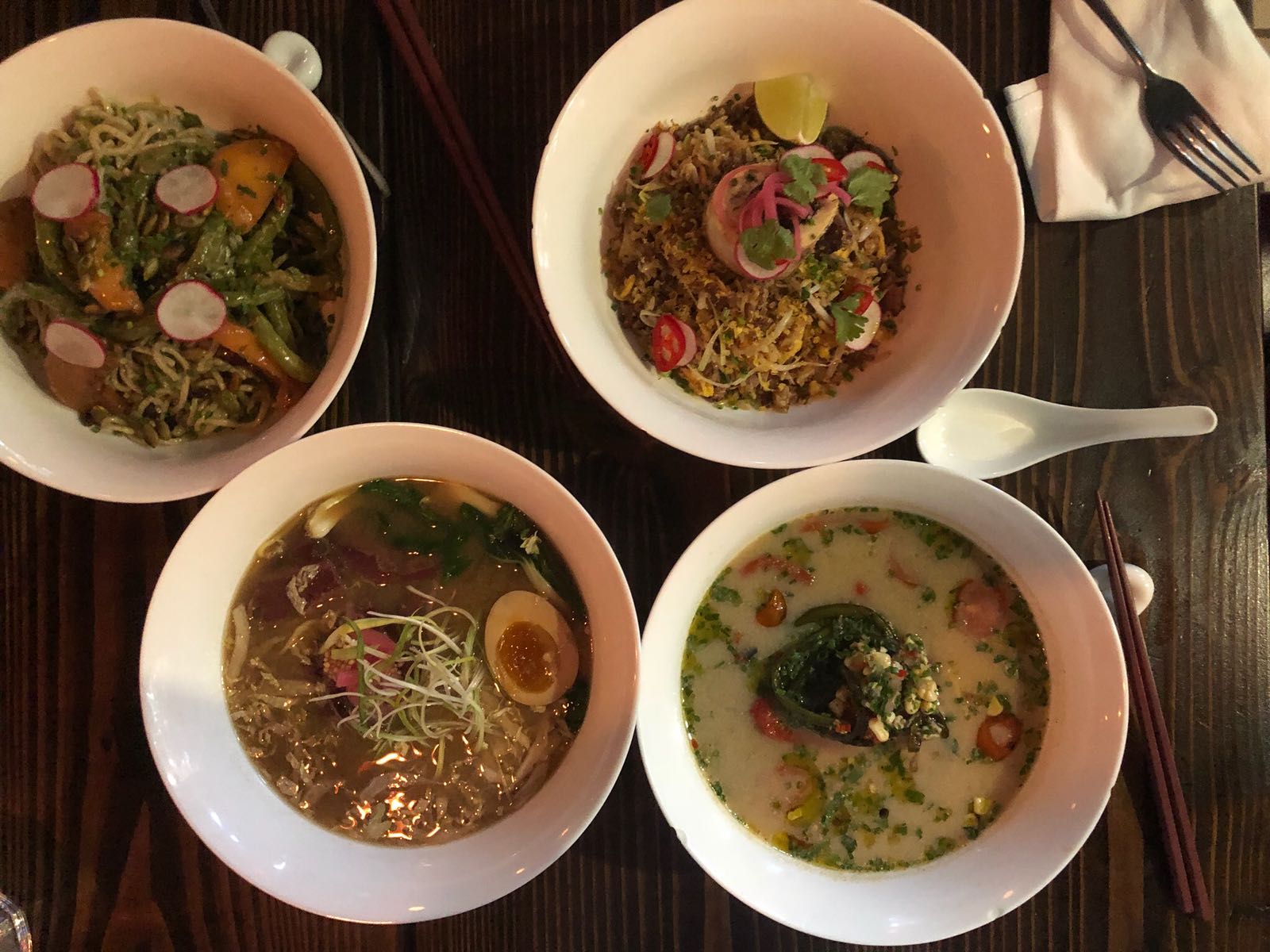
Ramen Is Far From Chicken Soup
The main event at Boru Boru is, of course, the giant bowls of ramen. Perfecting ramen is an art. Many chefs interviewed for the position at Boru Boru but bailed when they heard no bonito flakes or pork were allowed to be involved in the process. It’s so hard to get that rich flavor without umami-rich components like these, but that didn’t deter Chef Erick Vargas-Bromberg.
Erick got creative with flavor boosters and expansive with use of aromatics to create a rich and flavorful broth. Instead of focusing on the salty, umami-rich non-kosher ingredients, Erick decided to model the broth after the Vietnamese pho which uses a lot of aromatic additions such as coriander, cinnamon, peppercorns, star anise, and cardamom. They are toasted and added to broaden the reach of the broth so that it becomes a full-bodied and almost therapeutic experience.
Many components make a ramen special: there’s the broth, the noodles, the tare (seasoning type) and finally the add-ins. Each ingredient needs to be respected in order to create a ramen worth eating and enjoying.
Traditional ramen broth is made by boiling bones and base components like charred onions for hours. The sign of a quality ramen is that it gels when chilled, and it should have a robust, complex flavor, much more than your average chicken soup.
At Boru Boru, the ramen broth is boiled for at least 18 hours. A traditional ramen shop uses some of the last batch of broth in the next batch. This allows the flavors of the broth to deepen and gain complexity over time. It’s a beautiful tradition that keeps the continuity of a ramen going for years making it better and better over time. Some shops have broths that have technically been going for over 100 years. Boru Boru’s broth has been going since they opened six months ago, and Dan says it keeps getting better and better.
The noodles for the ramen were a challenge in and of itself. Quality ramen noodles do not come dried in a plastic packet. The process is a lengthy and regimented one. Most serious ramen shops do not make their own noodles; they purchase them from the noodle-making families that have been making the perfect chewy noodle for roughly a century.
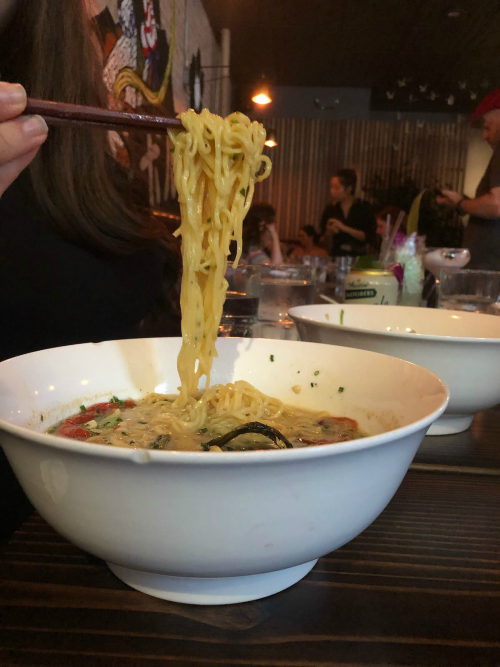
There is only one family that makes noodles with a hashgacha, and they are about as old school as it gets. They don’t deliver and can be a pain in the neck to work with but for good ramen you need the quality noodle with enough of a chew and stability so that it stands out in a ramen and doesn’t disintegrate no matter how long the bowl has been out. It also needs to be versatile and subtle enough to work with any broth and not overpower the rest of the ingredients. These noodles, my friend, are worth it.
Tare (pronounced ta-re) is an extra special addition of flavor in a ramen. It can be made from miso, mirin, soy sauce and so many more things. The purpose of it is to achieve the layers upon layers of flavor that ramen has.
So once the ramen broth is made, the tare is added in as that extra boom of flavor. The components of the tare and flavor depends on what soup it is added to help drive the direction of flavor in the bowl.
Finally, the add ins. These separate components, each a step of their own, create the final shape and flavor of the soup. When shaping a concept for ramen you want to balance the flavors of fresh bright ingredients to the deep strong flavors of the soup.
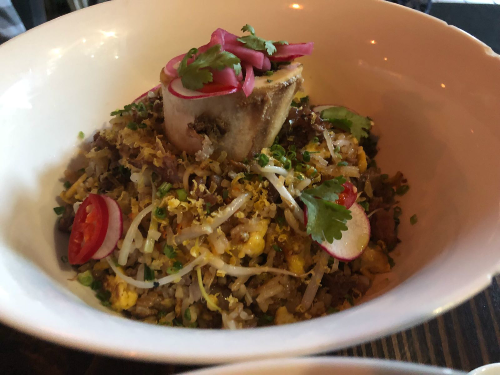
Usually you will have a mix of chilies, a modest amount of roasted and marinated meats or chicken, bright herbs and scallions, and other fresh and cooked vegetables. The soup may be finished with a drizzle of chili oil or soy sauce, pickles, and topped with my absolute favorite, and in my opinion totally necessary, marinated soft boiled egg.
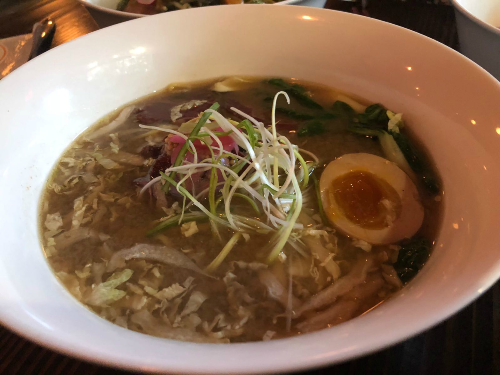
What is very different from what you would normally expect at a kosher restaurant is that the protein sizes are not overwhelmingly large. That is not how ramen is intended to be served. Instead, the purpose of the bowl is the balance of flavors together in balanced portions.
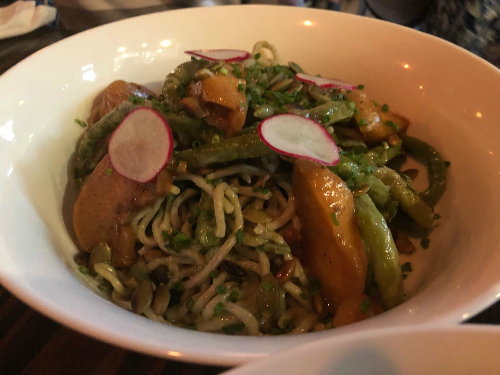
When your bowl arrives you immediately smell the complexity of the dish. It smells foreign and exciting at the same time. The steam caresses your face, inviting you to take your first bite.
And when you do, you begin to taste the multitude of layers that make up ramen. Each is distinct but blends into the next, creating a symphony of flavor and an adventure for the palate.
Each bite is a different experience as you pull in more of one component in a single bite and more of a different component in another. Sip broth, slurp noodles, crunch veg, repeat. You begin to lose yourself in the process, in the experience. No, this is not your Bubbie’s chicken soup.
Cuisine Of the Moment
A lot of Boru Boru’s menu is inspired by seasonal ingredients, and it changes depending on the season. Many of their fruits and vegetables are locally sourced from nearby farms, which give the dishes and incredibly fresh and bright flavor.
Their forward thinking doesn’t only apply to their cooking but to their approach to conservation and reducing food waste as well. “I think the coolest part of our kitchen is that we are for the most part a zero waste kitchen,” Dan says. “On an average night, we have only one bag of garbage for the whole kitchen. Everything gets used one way or another. Our vegetables we haven’t used become pickles, and the leftover bones from our chicken and pastrami go into the broth for our ramen.”
So how do we get more kosher-observant people comfortable with this full-hearted embrace of more robust, multi-ethnic cuisine? “I think kosher ingredients have come so far and are so much more accessible for the home cook,” says Dan. “We just need to teach people how to use them, make them not so intimidating, so that any Shabbos table can be filled with dishes made with new kosher ingredients.
“There’s no reason why miso shouldn’t have a place in the barbecue sauce that you’re pouring over your brisket, you know?”
Speaking with friends after the experience helped open my eyes to how ready the Jewish world is for these incredible leaps in kosher food. Friends I have spoken with have been amazed at the incredible flavors and dishes they have tasted and have reported going back two or three times since their first experience, addicted to the intrigue and mystery.
Boru Boru represents the incredible change the Jewish world is opening up to in terms of food. We are ready for the next big step into a place beyond shredded beef tacos and tuna tartare.
The world is changing, cultures are being shared across social media, and the world is getting smaller. We have the opportunity to open ourselves up to incredible knowledge and beautiful new things every single day. All we have to do is keep our minds and stomachs open to what is happening around us.
Dan’s mission to educate the kosher world about these new foods is always done respectfully without any judgement. In fact, it was part of his motivation to open a kosher restaurant, an opportunity to open the eyes of the kosher world to what food could be! “Everyone learns from somewhere. So when someone comes into the shop and asks, “What is this ray-men I have heard so much about?” Dan smiles, even when it’s the 40th time that night, and says “Everyone loves raymen!”



